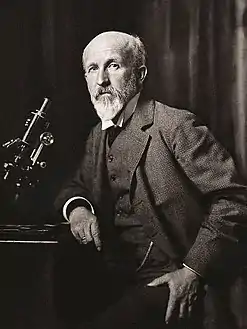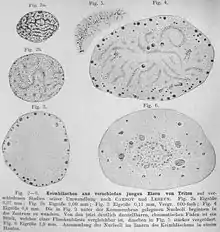أوسكار هيرتويغ
أوسكار هيرتويغ (بالألمانية: Oscar Hertwig) (21 أبريل 1849 في فريدبيرغ - 25 أكتوبر 1922 في برلين) كان أستاذ عالم الحيوان ألماني، والذي كتب أيضا في حوالي عام 1916 عن نظرية التطور، وذلك بعد أكثر من 55 عاما بعد كتاب تشارلز داروين "أصل الأنواع". وهو الأخ الأكبر لأخصائي علم الحيوان ريتشارد هيرتويغ (1850-1937). وكان الأخوة هيرتويغ مع إرنست هيكل ( وكارل جيجنباور ) من من أبرز علماء جامعةجامعة ينا.
| أوسكار هيرتويغ Oscar Hertwig | |
|---|---|
| (بالألمانية: Oscar Hertwig) | |
 أوسكار هيرتويغ من نيكولا بيرسشيد | |
| معلومات شخصية | |
| اسم الولادة | (بالألمانية: Oscar Wilhelm August Hertwig) |
| الميلاد | 21 أبريل 1849 فريدبرغ (هسن), دوقية هسن الكبرى |
| الوفاة | 25 أكتوبر 1922 (73 سنة)
برلين |
| الجنسية | ألمانيا |
| عضو في | الأكاديمية الألمانية للعلوم ليوبولدينا ، والأكاديمية الملكية السويدية للعلوم ، والأكاديمية البروسية للعلوم |
| أبناء | بولا هيرتويغ [1] |
| إخوة وأخوات | |
| الحياة العملية | |
| المدرسة الأم | جامعة ينا |
| مشرف الدكتوراه | إرنست هيكل |
| تعلم لدى | إرنست هيكل |
| المهنة | عالم حيوانات ، وأستاذ جامعي ، وعالم تشريح ، وعالم أحياء |
| اللغات | الألمانية [2] |
| مجال العمل | علم الحيوان |
| موظف في | جامعة ينا ، وجامعة فريدرش فيلهيلم في برلين ، وجامعة هومبولت في برلين |
| سبب الشهرة | طلائعيات |

Illustration from O. Hertwig's book Lehrbuch der Entwicklungsgeschichte des Menschen und der Wirbeltiere (Textbook of developmental history of humans and vertebrates), 1906.
انظر أيضا
- علم التخلق.
- تطور – مفاهيم وتاريخ الفكر التطوري.
مراجع
- Paula Hertwig — تاريخ الاطلاع: 3 يوليو 2019 — المخترع: أوليه دانيال إنرسن
- http://data.bnf.fr/ark:/12148/cb103132992 — تاريخ الاطلاع: 10 أكتوبر 2015 — المؤلف: المكتبة الوطنية الفرنسية — الرخصة: رخصة حرة
- Gill, P (1990), "Nature and nurture.", Med. J. Aust. (نشر Apr 2, 1990), 152 (7), صفحة 386, PMID 2093819 الوسيط
|CitationClass=تم تجاهله (مساعدة); الوسيط|separator=تم تجاهله (مساعدة)CS1 maint: ref=harv (link) - Weindling, P (1980), "Social concepts in anatomy: theories of the cell state of Oscar Hertwig (1849–1922) and Wilhelm Waldeyer (1836–1921).", The Society for the Social History of Medicine bulletin (نشر Jun 1980), 26, صفحات 15–7, PMID 11610800 الوسيط
|CitationClass=تم تجاهله (مساعدة); الوسيط|separator=تم تجاهله (مساعدة)CS1 maint: ref=harv (link) - Gras, N; Verchere, M; Santoro, J P (1975), "[The Oscar Hertwig centenary]", Revue d'odonto-stomatologie, 4 (2), صفحات 135–40, PMID 1103253 الوسيط
|CitationClass=تم تجاهله (مساعدة); الوسيط|separator=تم تجاهله (مساعدة)CS1 maint: ref=harv (link) - Churchill, F B (1970), "Hertwig, Weismann, and the meaning of reduction division circa 1890.", Isis; an international review devoted to the history of science and its cultural influences, 61 (4), صفحات 429–57, doi:10.1086/350680, PMID 4942056 الوسيط
|CitationClass=تم تجاهله (مساعدة); الوسيط|separator=تم تجاهله (مساعدة)CS1 maint: ref=harv (link) - Cremer, T. 1985. Von der Zellenlehre zur Chromosomentheorie. Springer Vlg., Heidelberg. This German book can be downloaded here .
- Krafft, F., and A. Meyer-Abich (ed.). 1970. Große Naturwissenschaftler – Biographisches Lexikon. Fischer Bücherei GmbH, Frankfurt a. M. & Hamburg.
- Mol. Cell. Biol.-lecture, Heidelberg, D.-H. Lankenau.Early to recent key-discoveries: From Germline Theory to Modern Gene Modification
- Weindling, Paul. 1991. Darwinism and Social Darwinism in Imperial Germany: The Contribution of the Cell Biologist Oscar Hertwig (1849–1922). Forschungen zur Medizin- und Biologiegeschichte vol. 3, (Stuttgart: G. Fischer in association with Akademie der Wissenschaften und der Literatur Mainz, 1991),
- David Ellyard, "Who discovered what when", New Holland Publishers (Australia) Private Limited, 2005, p. 274.
- C. R. Austin, "The mammalian egg", Blackwell Scientific Publications, Oxford, 1961.
روابط خارجية
- أوسكار هيرتويغ على موقع Encyclopædia Britannica Online (الإنجليزية)
- أوسكار هيرتويغ على موقع المكتبة المفتوحة (الإنجليزية)
- مؤلفات Oscar Hertwig في مشروع غوتنبرغ
- أعمال أو نبذة عن أوسكار هيرتويغ على أرشيف الإنترنت
- The first chapters of O. Hertwig's book Lehrbuch der Entwicklungsgeschichte des Menschen und der Wirbeltiere (1906) are available online here
- بوابة أعلام
- بوابة ألمانيا
- بوابة الإمبراطورية الألمانية
- بوابة تاريخ العلوم
- بوابة طب
- بوابة علم الأحياء
أوسكار هيرتويغ في المشاريع الشقيقة
 صور وملفات صوتية من كومنز
صور وملفات صوتية من كومنز أنواع من ويكي أنواع.
أنواع من ويكي أنواع.
This article is issued from Wikipedia. The text is licensed under Creative Commons - Attribution - Sharealike. Additional terms may apply for the media files.